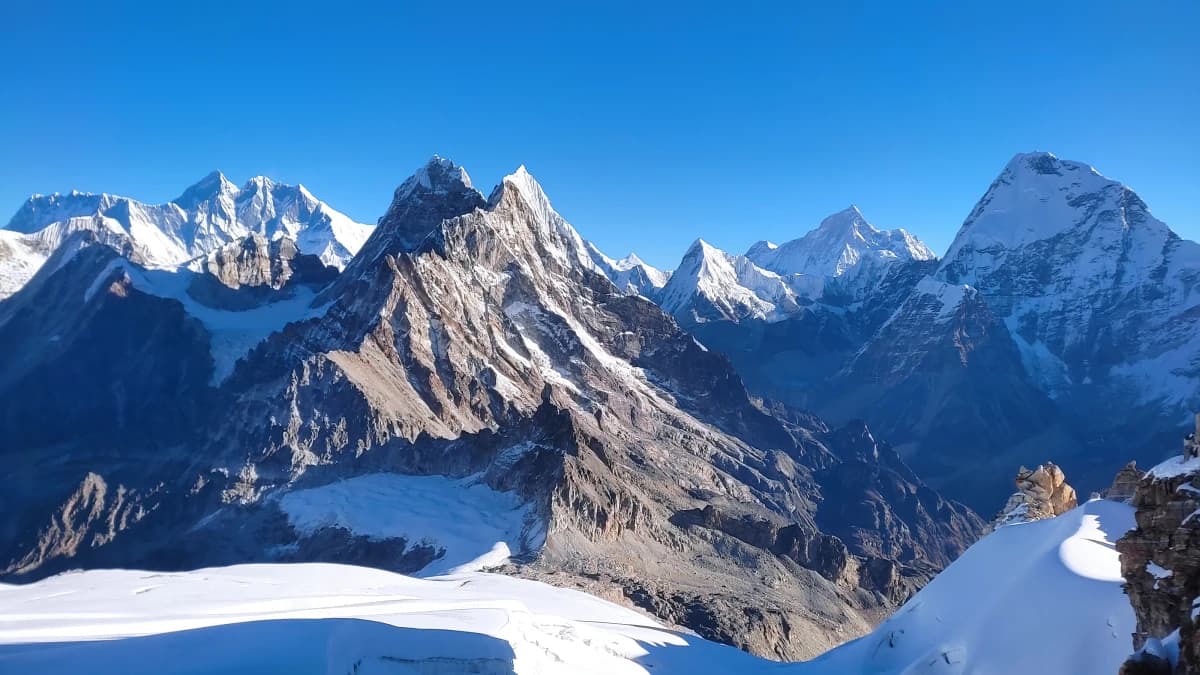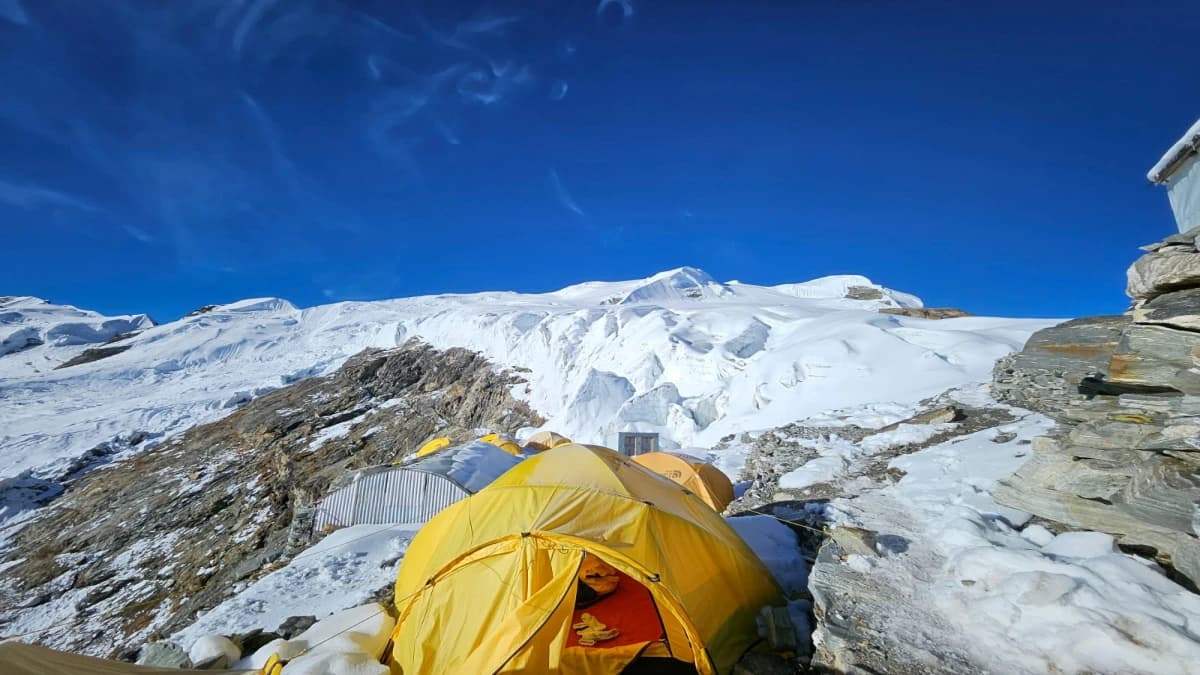Mera Peak Climbing - Nepal's Highest Trekking Peak
Mera Peak Climbing is a demanding in Nepal's Himalayan region, yet worthwhile experience. At an astounding 6,461 meters (21,190 ft), it is regarded as Nepal's highest trekking peak. On this trekkers can experience a unique combination of high-altitude hiking, stunning mountain views, and a chance to fully immerse themselves in the rich Sherpa culture.
The Mera Peak expedition will start from Lukla after you land. From there we will trek uphill to Mera Peak base camp. It is one of the easy trekking peaks in Nepal. Those who have regularly done physical activities will easily climb the Mera Peak. Peak is not so difficult, but it has some technical parts we must practice while trekking to Mera Peak. Our expert guide will assist you in climbing the Mera Peak. They are good climbers and have already summited many different mountains in their careers.
After boarding a picturesque and dangerous flight to Lukla, our 18-day Mera Peak climbing itinerary has started. Two summit days are included in the eighteen actual trekking and climbing days. That day we will stay at Lukla and do a short hike for our body to fix the altitude. The next day we will trek to Chutanga. Similarly, you will go through the jungle and up paths as you make your way to Chutanga. You will spend the night in the mountains and thereafter travel towards Thuli Kharka. You will proceed to trek toward Kothe and then Thangnak. With each height climb, the voyage becomes more difficult and adventurous. It’s also difficult because you have to cross the Zatrwa La pass. Crossing the pass provides an exciting challenge, as the trail ascends through forests of rhododendron and juniper before reaching the ridge. From here, trekkers are rewarded with breathtaking panoramas of the Khumbu region.
Following the Mera Peak trekking route, we will stop at Khare from Thangnak. Khare is the last point for Mera Peak climbing. We will take an acclimatization in Khare. By practicing and training for peak climbing, we will spend our night at Khare .
What is the highlight of Mera Peak?
- Highest Altitude Trekking Peak: At 6,476 meters (21,247 feet), Mera Peak is the highest trekking peak in Nepal, offering a challenging yet non-technical climb.
- Trek through Zatra La Pass and the picturesque Hinku Valley.
- Panoramic Mountain Views: The summit offers breathtaking views of Everest, Lhotse, Makalu, Cho Oyu, and Kangchenjunga, five of the highest peaks in the world.
- Scenic Trails: The hike highlights the splendor of the Hinku Valley by passing through charming villages, thick rhododendron forests, and high alpine terrain.
- Higher Summit Preparation: For individuals who want to ascend higher summits like Everest or other 7000–8000-meter peaks, this peak is a great starting point.
- Beautiful Glaciers and Ice Climbing: The trip offers a feeling of authentic mountaineering by having participants walk over snowfields and glaciers.
- Cultural Exploration: Interactions with the Sherpa communities allow trekkers to experience the rich culture and traditions of the Himalayan people.
Mera Peak Climbing route easy?
Mera Peak climbing route is carefully planned, with a moderate ascent and a full day off in Khare to allow for proper acclimatization. This plan covers an 18-day climb of Mera Peak in Nepal. The journey begins with a departure from Kathmandu, followed by a breathtaking 35-minute flight to Lukla. Then you'll travel to Chhutang, Thuli Kharka over the stunning Zatra La Pass, Kothe, Thagnak, and finally Khare. After one full day of acclimatization in Khare, your journey will begin at Mera Peak Base Camp, then to Mera High Camp, and ultimately to Mera Peak Summit.
Mera Peak itinerary & cost is available to all adventure seekers who are fit and healthy. So, hurry up and plan your Mera Peak Climbing along with the Zatra La Pass trek by talking with one of our local travel professionals who can assist you in planning your Nepal trip.
How Expensive Mera Peak Climbing with Permit ?
Not expensive compare you get a service for 18 days with peak climbing permit and national park and local government fee. Apart from the usual path for Mera Peak Climbing, you can also finish this climbing journey through the Everest Base Camp route. After getting to Lukla, you will trek to Namche Bazaar. It is one of the highest trading hubs in the world. From Namche Bazaar, you ascend to Mera Base Camp, then to High Camp, and ultimately to the summit the Mera Peak .We provide best price for 2025-2026 Climbing Mera Peak, Nepal's highest trekking peak at 6,476 meters, is an amazing experience. Permits, guide and porter fees, lodging, and food throughout the journey are all included in the expedition's price. Usually included in this cost are flights to Lukla, hiking permits, base camp amenities,Climbing sherpa professional advice to guarantee a fun and safe climb. Peak climbing cost depand the size of the group, and the package selected can all affect the price.
What is the best time for Mera Peak Climbing?
Climbing Mera Peak is not an easy task, but it is exciting when you reach the summit at 6,476 meters (21,247 feet). Therefore, choosing the right time will enable you to handle the climbing challenge of Mera Peak. The journey is gorgeous all year, but the best time for Mera Peak Climbing is fall (September, October, and November) and spring (March, April, and May). The excitement of climbing Mera Peak is increased by the unique splendor of the environment, the flora and wildlife, and the clear sky and perfect weather.
Who am I climbing with?
We are always focused on the safety of clients. So, we always prefer an IFMGA guide and a local guide who helps you in the entire trek. Some climbing leaders have also summited Mt. Everest at least once or a few times in their climbing careers. Your guide will provide you with important tips and teach you the tricks while assisting you from day one. He will also provide you with pre-climbing training the day before the summit base camp. A lot of heap operators do not take this climbing trip seriously, risking your health or well-being, so be very prudent when you choose your climbing operator.
Why with Attentive holidays?
Local guides with extensive training, certification, and years of expertise make up our staff. They are amiable and simple to talk to. You will undoubtedly appreciate their friendliness and service. They have received training on how to effectively manage any difficult situation that may arise. Our climbing package can be customized as per your needs and the number of days you have for trekking.
We have been providing services for the last 15 years. We are officially registered with the Department of Tourism Ministry, the government of Nepal, and affiliated with tourism organizations: Nepal Association of Tour and Travel Agents (NATTA), certified by the Nepal Tourism Board (NTB), Trekking Agency Association of Nepal (TAAN), and Nepal Mountaineering Association (NMA).

.webp&w=3840&q=75&dpl=dpl_EbgeQs1w4UPUwnPAPCwZpToZ7rAt)

